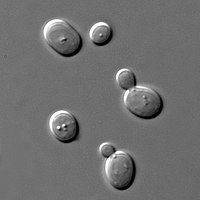
Asymmetric Segregation of Aged Spindle Pole Bodies During Cell Division: Mechanisms and Relevance Beyond Budding Yeast?
Sign Up to like & getrecommendations! Published in 2018 at "BioEssays"
DOI: 10.1002/bies.201800038
Abstract: Asymmetric cell division generates cell diversity and contributes to cellular aging and rejuvenation. Here, we review the molecular mechanisms enabling budding yeast to recognize spindle pole bodies (SPB, centrosome equivalent) based on their age, and… read more here.
Keywords: budding yeast; cell division; spindle pole; segregation ... See more keywords

Intrinsic and Extrinsic Determinants Linking Spindle Pole Fate, Spindle Polarity, and Asymmetric Cell Division in the Budding Yeast S. cerevisiae.
Sign Up to like & getrecommendations! Published in 2017 at "Results and problems in cell differentiation"
DOI: 10.1007/978-3-319-53150-2_3
Abstract: The budding yeast S. cerevisiae is a powerful model to understand the multiple layers of control driving an asymmetric cell division. In budding yeast, asymmetric targeting of the spindle poles to the mother and bud… read more here.
Keywords: budding yeast; division; yeast cerevisiae; fate ... See more keywords

Spindle pole cohesion requires glycosylation-mediated localization of NuMA
Sign Up to like & getrecommendations! Published in 2017 at "Scientific Reports"
DOI: 10.1038/s41598-017-01614-6
Abstract: Glycosylation is critical for the regulation of several cellular processes. One glycosylation pathway, the unusual O-linked β-N-acetylglucosamine glycosylation (O-GlcNAcylation) has been shown to be required for proper mitosis, likely through a subset of proteins that… read more here.
Keywords: galectin; cohesion; glycosylation; spindle pole ... See more keywords

Spindle pole body duplication defective yeast cells are more prone to membrane damage
Sign Up to like & getrecommendations! Published in 2019 at "Mycologia"
DOI: 10.1080/00275514.2019.1659091
Abstract: ABSTRACT Correct separation of chromosomes during mitosis is essential for preventing genetic instability and aneuploidy. Such separation is dependent on correct duplication of the nuclear-associated microtubular organizing center, i.e., spindle pole body (SPB), in fungi.… read more here.
Keywords: yeast cells; duplication defective; spindle pole; pole body ... See more keywords

Spindle pole bodies function as signal amplifiers in the Mitotic Exit Network
Sign Up to like & getrecommendations! Published in 2020 at "Molecular Biology of the Cell"
DOI: 10.1091/mbc.e19-10-0584
Abstract: The Mitotic Exit Network (MEN), a budding yeast Ras-like signal transduction cascade, translates nuclear position into a signal to exit from mitosis. Here we describe how scaffolding the MEN onto spindle pole bodies (SPB—centrosome equivalent)… read more here.
Keywords: exit; mitotic exit; exit network; mitosis ... See more keywords

Human microcephaly ASPM protein is a spindle pole-focusing factor that functions redundantly with CDK5RAP2
Sign Up to like & getrecommendations! Published in 2017 at "Journal of Cell Science"
DOI: 10.1242/jcs.203703
Abstract: ABSTRACT Nonsense mutations in the ASPM gene have been most frequently identified among familial microcephaly patients. Depletion of the Drosophila orthologue (asp) causes spindle pole unfocusing during mitosis in multiple cell types. However, it remains… read more here.
Keywords: protein; pole focusing; microcephaly; spindle pole ... See more keywords

Analysis of the protein composition of the spindle pole body during sporulation in Ashbya gossypii
Sign Up to like & getrecommendations! Published in 2019 at "PLoS ONE"
DOI: 10.1371/journal.pone.0223374
Abstract: The spores of fungi come in a wide variety of forms and sizes, highly adapted to the route of dispersal and to survival under specific environmental conditions. The ascomycete Ashbya gossypii produces needle shaped spores… read more here.
Keywords: sporulation; pole body; spindle pole; ashbya gossypii ... See more keywords

CEP215 and AURKA regulate spindle pole focusing and aMTOC organization in mouse oocytes.
Sign Up to like & getrecommendations! Published in 2020 at "Reproduction"
DOI: 10.1530/rep-19-0263
Abstract: Acentriolar microtubule-organizing centers (aMTOCs) play a critical role in stable meiotic spindle assembly in oocytes, necessary for accurate chromosome segregation. Yet, there is a limited understanding of the essential regulatory components of these unique MTOCs.… read more here.
Keywords: organization; mouse oocytes; amtoc organization; pole focusing ... See more keywords

Extra Spindle Pole Bodies-Like 1 Serves as a Prognostic Biomarker and Promotes Lung Adenocarcinoma Metastasis
Sign Up to like & getrecommendations! Published in 2022 at "Frontiers in Oncology"
DOI: 10.3389/fonc.2022.930647
Abstract: Extra spindle pole bodies-like 1 (ESPL1), a cysteine endopeptidase, plays a vital role in chromosome inheritance. However, the association of ESPL1 with prognosis and immune infiltration in lung adenocarcinoma (LUAD) has not yet been explored.… read more here.
Keywords: bodies like; luad; extra spindle; pole bodies ... See more keywords

Knockdown of spindle pole body component 25 homolog inhibits cell proliferation and cycle progression in prostate cancer
Sign Up to like & getrecommendations! Published in 2018 at "Oncology Letters"
DOI: 10.3892/ol.2018.8003
Abstract: Prostate cancer (PCa) is the most frequently diagnosed type of cancer in Chinese males. Cell-cycle aberration is a hallmark of cancer. Spindle pole body component 25 homolog (SPC25), a component of the Ndc80 complex, serves… read more here.
Keywords: cell proliferation; prostate cancer; pca; spindle pole ... See more keywords

Polo-like kinase Cdc5 regulates Spc72 recruitment to spindle pole body in the methylotrophic yeast Ogataea polymorpha
Sign Up to like & getrecommendations! Published in 2017 at "eLife"
DOI: 10.7554/elife.24340
Abstract: Cytoplasmic microtubules (cMT) control mitotic spindle positioning in many organisms, and are therefore pivotal for successful cell division. Despite its importance, the temporal control of cMT formation remains poorly understood. Here we show that unlike… read more here.
Keywords: ogataea polymorpha; like kinase; recruitment; polo like ... See more keywords